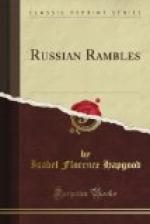The count has no longer a school for the peasant children, by the way. The necessity for that is past. But he must have been an original professor. A friend of mine in St. Petersburg, who was interested, during the sixties, in the secular Sunday-schools for workingmen who could not attend on week days, repeated to me the count’s method as imparted to her by himself while visiting the capital. He objected to the rules which compelled the men to be regular in attendance, on the ground that learning must not be acquired thus mechanically, under compulsion, but when the scholar feels an inward impulse. He would not listen to the suggestion that this method would hardly answer when study must be prosecuted on specified days under penalty of eternal ignorance. He said that when he found his peasant pupils indisposed to learn he dismissed the school, went home, and occupied himself in his own affairs. After an interval, more or less long, a scuffling of feet and a rapping would become audible at the door, and small voices would plead: “Please, Lyeff Nikola’itch, we want to study. Please, come and teach us.” He went, and they made rapid progress because all was purely voluntary.
One of the whitened stone wings of the old manor house stands unchanged. It is occupied in summer by the countess’s sister and her family. She is a handsome and clever woman, who translates, and who has written some strong short stories. The wing used by the count has been enlarged to meet the requirements of the large family, and yet it is not a great or imposing house. At one end a stone addition, like the original building, contains, on the ground floor, the count’s two rooms, which open on an uncovered stone terrace facing the hedge-inclosed lawn, with beds of bright flowers bordering it, and the stately lindens of the grand avenues waving their crests beyond in the direction of the ponds. Over these rooms and the vestibule is the hall, indispensable as a dining-room and a play-room for the small children in wet weather and in winter. A wooden addition at the other end furnishes half a dozen rooms for members of the family, the tutor and the maids. Near by stand several log cottages,—the bakehouse, the servants’ dining-room, and other necessary offices.
The count’s study is very plain. The walls are in part lined with bookcases; in part they are covered with portraits of relatives and of distinguished persons whom he admires. There are more bookcases in the vestibule, for people are constantly sending him books of every conceivable sort. I imagine that the first copies of every book, pamphlet, and journal on any hobby or “ism,” especially from America, find their way to the address of Count Tolstoy. He showed me some very wild products of the human brain. The hall upstairs has a polished wood floor, as is usual with such rooms, and a set of very simple wicker furniture. Portraits of ancestors, some of whom figure in “War and Peace,”




